Analyzing Big Data: Improving Education with Text Analytics Techniques
VerifiedAdded on 2023/01/10
|18
|5683
|93
Report
AI Summary
This report provides a detailed analysis of big data analytics within the context of education. It begins with an introduction to big data, outlining its characteristics and sources, and then explores its applications in education, such as measuring student understanding, personalizing learning experiences, and designing curricula. The report delves into big data text analytics, discussing its role in improving education through the analysis of student feedback from various sources. It contrasts text analytics with audio and video analytics and describes the application of descriptive, prescriptive, predictive, and diagnostic analytics to enhance educational practices. The report emphasizes the significance of qualitative feedback, the design of new courses, and the evaluation of teaching standards. It concludes by underscoring the potential of big data analytics to transform educational institutions by improving service delivery and curriculum design. The report includes an extensive bibliography to support its findings.
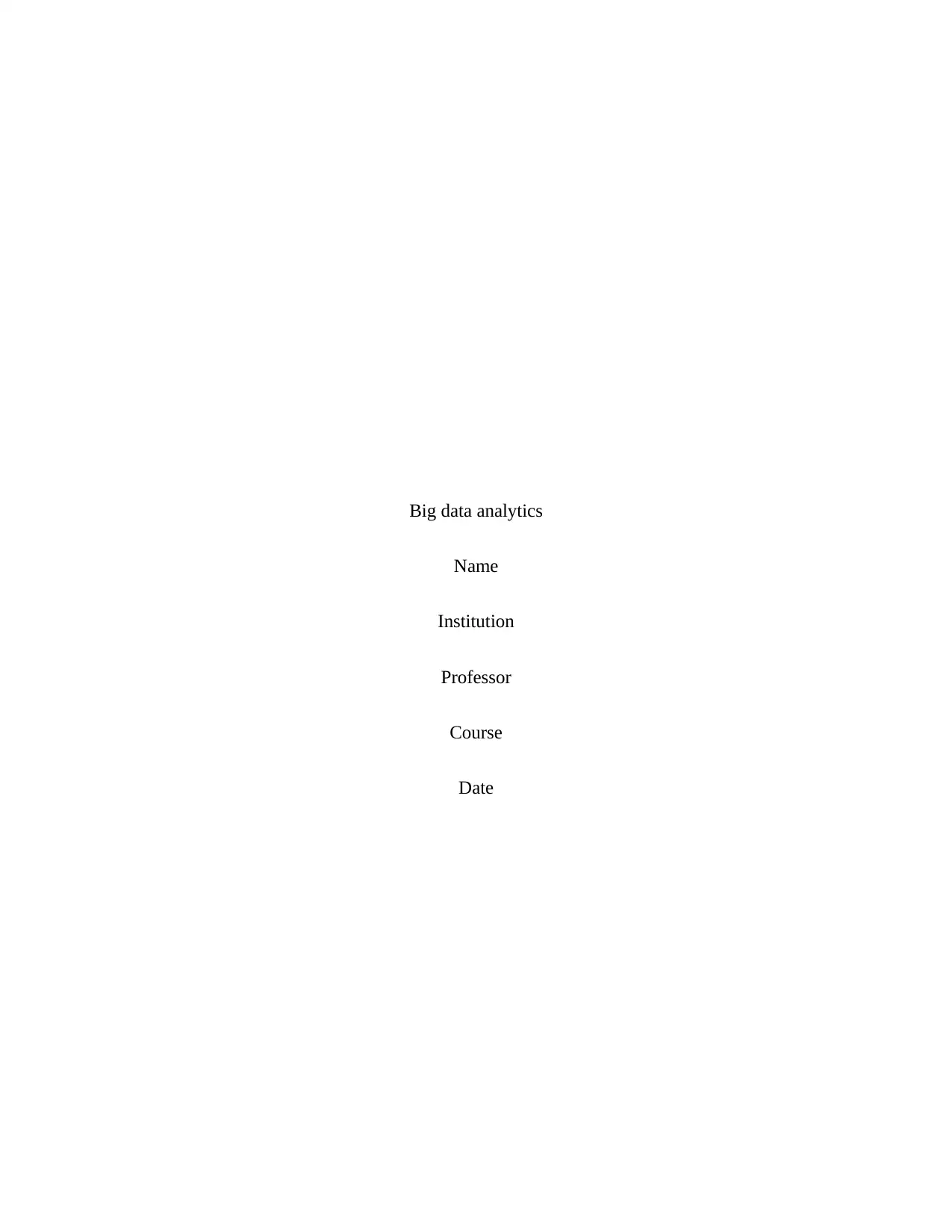
Big data analytics
Name
Institution
Professor
Course
Date
Name
Institution
Professor
Course
Date
Paraphrase This Document
Need a fresh take? Get an instant paraphrase of this document with our AI Paraphraser
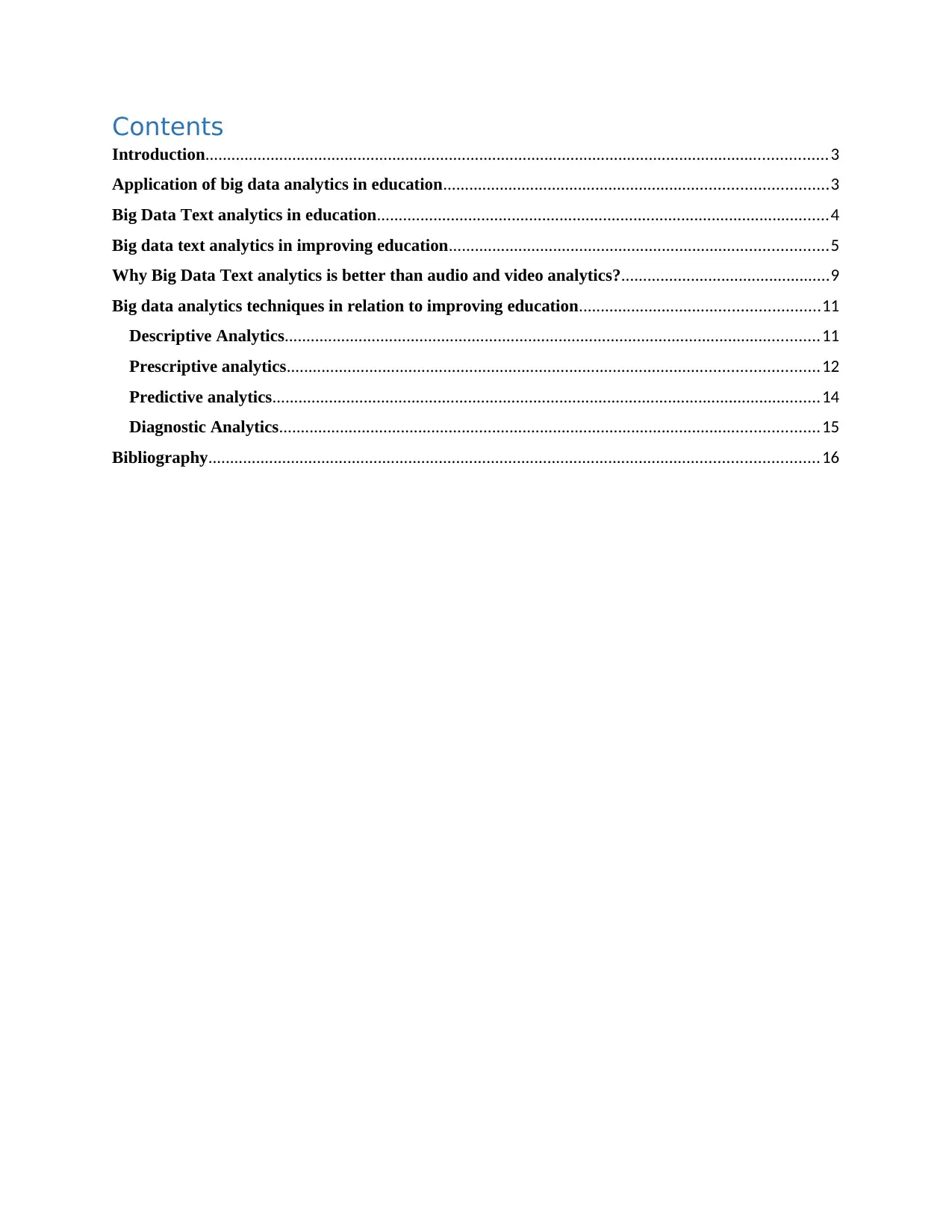
Contents
Introduction...............................................................................................................................................3
Application of big data analytics in education........................................................................................3
Big Data Text analytics in education........................................................................................................4
Big data text analytics in improving education.......................................................................................5
Why Big Data Text analytics is better than audio and video analytics?................................................9
Big data analytics techniques in relation to improving education.......................................................11
Descriptive Analytics...........................................................................................................................11
Prescriptive analytics..........................................................................................................................12
Predictive analytics..............................................................................................................................14
Diagnostic Analytics............................................................................................................................15
Bibliography............................................................................................................................................16
Introduction...............................................................................................................................................3
Application of big data analytics in education........................................................................................3
Big Data Text analytics in education........................................................................................................4
Big data text analytics in improving education.......................................................................................5
Why Big Data Text analytics is better than audio and video analytics?................................................9
Big data analytics techniques in relation to improving education.......................................................11
Descriptive Analytics...........................................................................................................................11
Prescriptive analytics..........................................................................................................................12
Predictive analytics..............................................................................................................................14
Diagnostic Analytics............................................................................................................................15
Bibliography............................................................................................................................................16
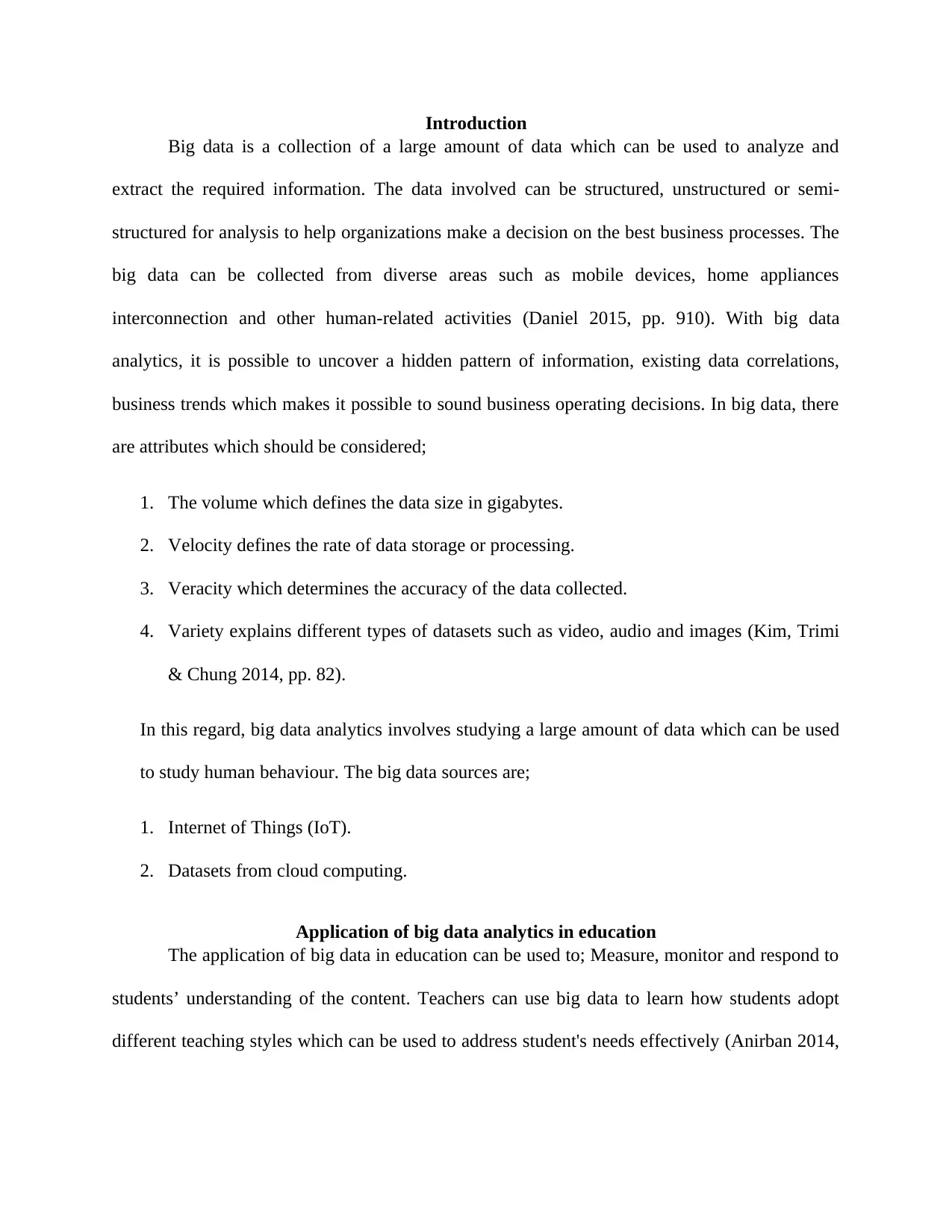
Introduction
Big data is a collection of a large amount of data which can be used to analyze and
extract the required information. The data involved can be structured, unstructured or semi-
structured for analysis to help organizations make a decision on the best business processes. The
big data can be collected from diverse areas such as mobile devices, home appliances
interconnection and other human-related activities (Daniel 2015, pp. 910). With big data
analytics, it is possible to uncover a hidden pattern of information, existing data correlations,
business trends which makes it possible to sound business operating decisions. In big data, there
are attributes which should be considered;
1. The volume which defines the data size in gigabytes.
2. Velocity defines the rate of data storage or processing.
3. Veracity which determines the accuracy of the data collected.
4. Variety explains different types of datasets such as video, audio and images (Kim, Trimi
& Chung 2014, pp. 82).
In this regard, big data analytics involves studying a large amount of data which can be used
to study human behaviour. The big data sources are;
1. Internet of Things (IoT).
2. Datasets from cloud computing.
Application of big data analytics in education
The application of big data in education can be used to; Measure, monitor and respond to
students’ understanding of the content. Teachers can use big data to learn how students adopt
different teaching styles which can be used to address student's needs effectively (Anirban 2014,
Big data is a collection of a large amount of data which can be used to analyze and
extract the required information. The data involved can be structured, unstructured or semi-
structured for analysis to help organizations make a decision on the best business processes. The
big data can be collected from diverse areas such as mobile devices, home appliances
interconnection and other human-related activities (Daniel 2015, pp. 910). With big data
analytics, it is possible to uncover a hidden pattern of information, existing data correlations,
business trends which makes it possible to sound business operating decisions. In big data, there
are attributes which should be considered;
1. The volume which defines the data size in gigabytes.
2. Velocity defines the rate of data storage or processing.
3. Veracity which determines the accuracy of the data collected.
4. Variety explains different types of datasets such as video, audio and images (Kim, Trimi
& Chung 2014, pp. 82).
In this regard, big data analytics involves studying a large amount of data which can be used
to study human behaviour. The big data sources are;
1. Internet of Things (IoT).
2. Datasets from cloud computing.
Application of big data analytics in education
The application of big data in education can be used to; Measure, monitor and respond to
students’ understanding of the content. Teachers can use big data to learn how students adopt
different teaching styles which can be used to address student's needs effectively (Anirban 2014,
⊘ This is a preview!⊘
Do you want full access?
Subscribe today to unlock all pages.

Trusted by 1+ million students worldwide
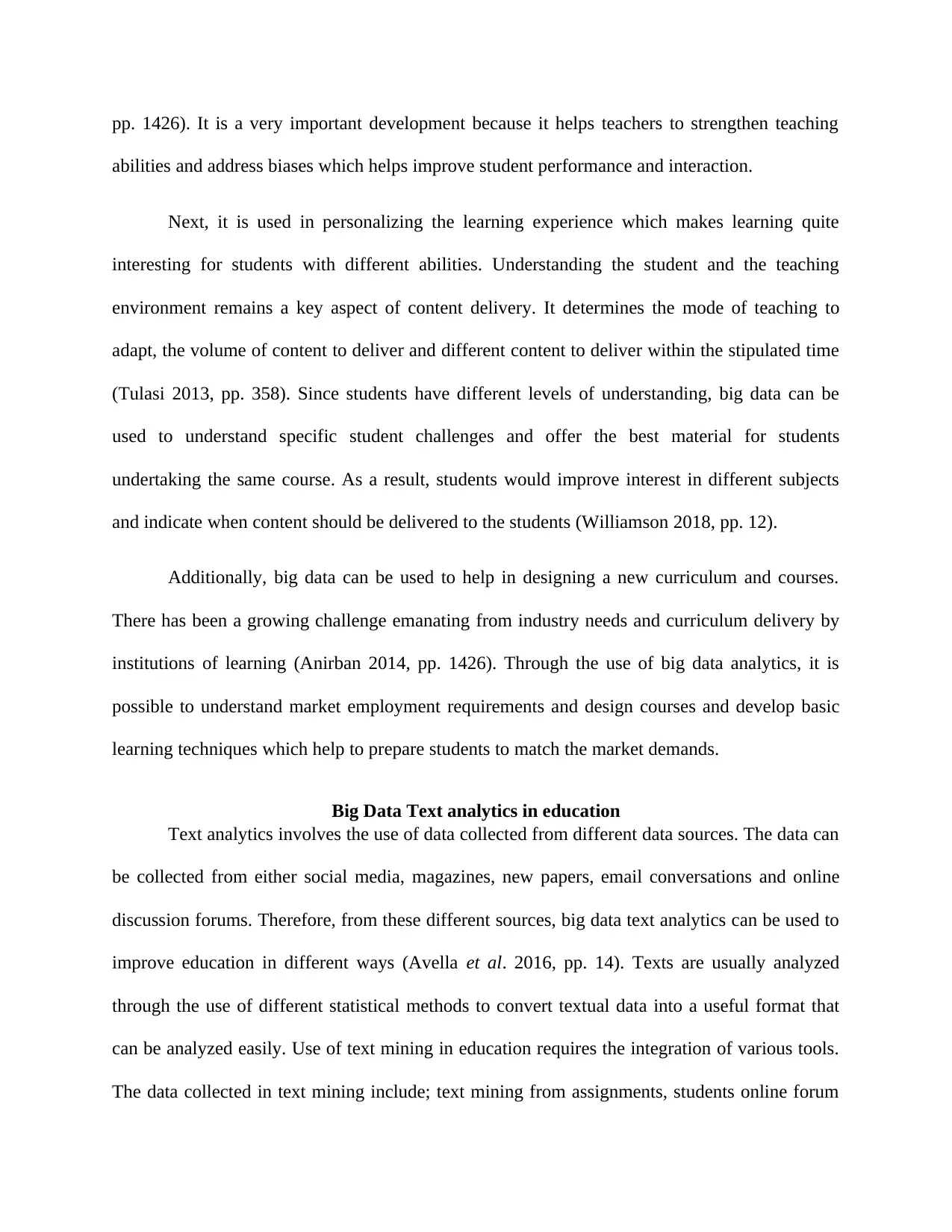
pp. 1426). It is a very important development because it helps teachers to strengthen teaching
abilities and address biases which helps improve student performance and interaction.
Next, it is used in personalizing the learning experience which makes learning quite
interesting for students with different abilities. Understanding the student and the teaching
environment remains a key aspect of content delivery. It determines the mode of teaching to
adapt, the volume of content to deliver and different content to deliver within the stipulated time
(Tulasi 2013, pp. 358). Since students have different levels of understanding, big data can be
used to understand specific student challenges and offer the best material for students
undertaking the same course. As a result, students would improve interest in different subjects
and indicate when content should be delivered to the students (Williamson 2018, pp. 12).
Additionally, big data can be used to help in designing a new curriculum and courses.
There has been a growing challenge emanating from industry needs and curriculum delivery by
institutions of learning (Anirban 2014, pp. 1426). Through the use of big data analytics, it is
possible to understand market employment requirements and design courses and develop basic
learning techniques which help to prepare students to match the market demands.
Big Data Text analytics in education
Text analytics involves the use of data collected from different data sources. The data can
be collected from either social media, magazines, new papers, email conversations and online
discussion forums. Therefore, from these different sources, big data text analytics can be used to
improve education in different ways (Avella et al. 2016, pp. 14). Texts are usually analyzed
through the use of different statistical methods to convert textual data into a useful format that
can be analyzed easily. Use of text mining in education requires the integration of various tools.
The data collected in text mining include; text mining from assignments, students online forum
abilities and address biases which helps improve student performance and interaction.
Next, it is used in personalizing the learning experience which makes learning quite
interesting for students with different abilities. Understanding the student and the teaching
environment remains a key aspect of content delivery. It determines the mode of teaching to
adapt, the volume of content to deliver and different content to deliver within the stipulated time
(Tulasi 2013, pp. 358). Since students have different levels of understanding, big data can be
used to understand specific student challenges and offer the best material for students
undertaking the same course. As a result, students would improve interest in different subjects
and indicate when content should be delivered to the students (Williamson 2018, pp. 12).
Additionally, big data can be used to help in designing a new curriculum and courses.
There has been a growing challenge emanating from industry needs and curriculum delivery by
institutions of learning (Anirban 2014, pp. 1426). Through the use of big data analytics, it is
possible to understand market employment requirements and design courses and develop basic
learning techniques which help to prepare students to match the market demands.
Big Data Text analytics in education
Text analytics involves the use of data collected from different data sources. The data can
be collected from either social media, magazines, new papers, email conversations and online
discussion forums. Therefore, from these different sources, big data text analytics can be used to
improve education in different ways (Avella et al. 2016, pp. 14). Texts are usually analyzed
through the use of different statistical methods to convert textual data into a useful format that
can be analyzed easily. Use of text mining in education requires the integration of various tools.
The data collected in text mining include; text mining from assignments, students online forum
Paraphrase This Document
Need a fresh take? Get an instant paraphrase of this document with our AI Paraphraser
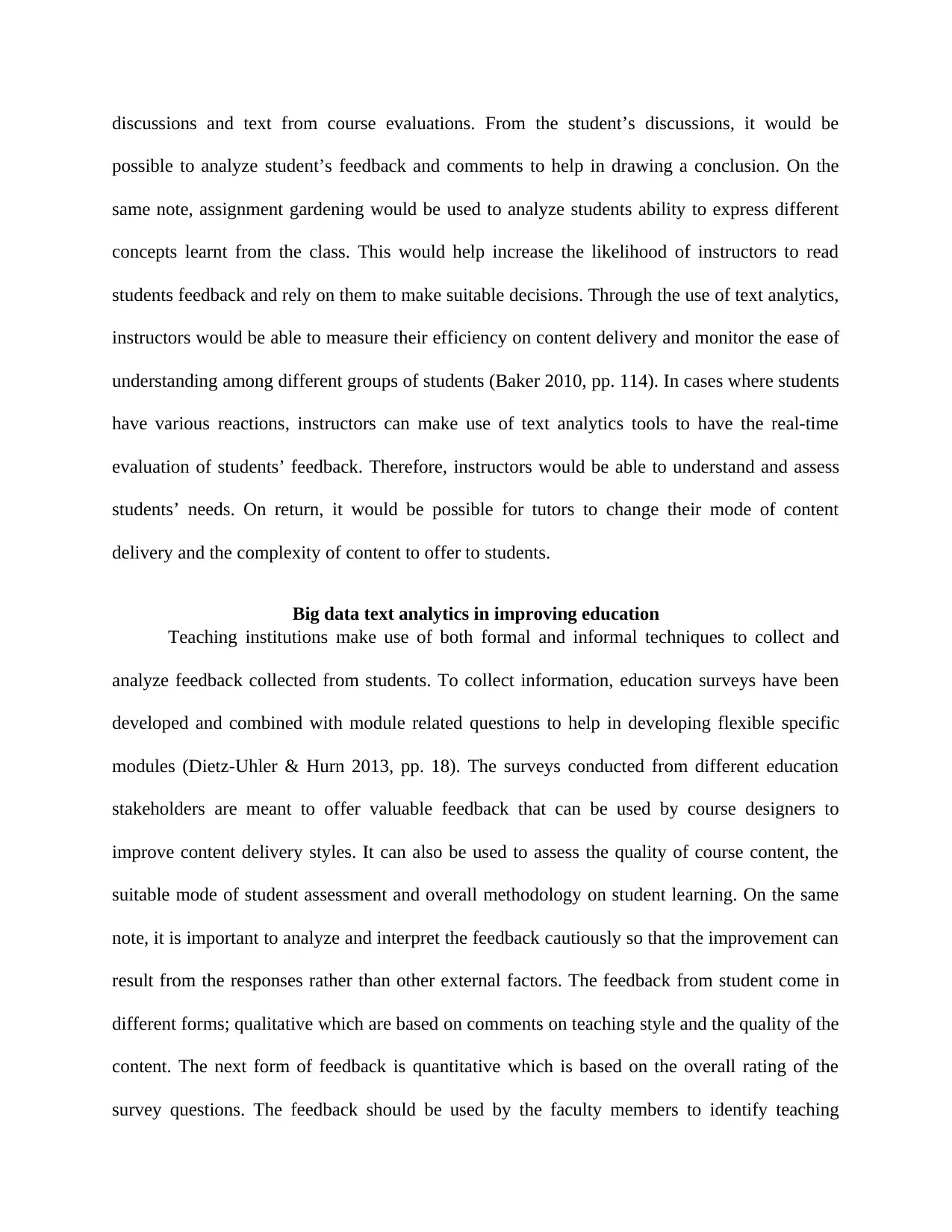
discussions and text from course evaluations. From the student’s discussions, it would be
possible to analyze student’s feedback and comments to help in drawing a conclusion. On the
same note, assignment gardening would be used to analyze students ability to express different
concepts learnt from the class. This would help increase the likelihood of instructors to read
students feedback and rely on them to make suitable decisions. Through the use of text analytics,
instructors would be able to measure their efficiency on content delivery and monitor the ease of
understanding among different groups of students (Baker 2010, pp. 114). In cases where students
have various reactions, instructors can make use of text analytics tools to have the real-time
evaluation of students’ feedback. Therefore, instructors would be able to understand and assess
students’ needs. On return, it would be possible for tutors to change their mode of content
delivery and the complexity of content to offer to students.
Big data text analytics in improving education
Teaching institutions make use of both formal and informal techniques to collect and
analyze feedback collected from students. To collect information, education surveys have been
developed and combined with module related questions to help in developing flexible specific
modules (Dietz-Uhler & Hurn 2013, pp. 18). The surveys conducted from different education
stakeholders are meant to offer valuable feedback that can be used by course designers to
improve content delivery styles. It can also be used to assess the quality of course content, the
suitable mode of student assessment and overall methodology on student learning. On the same
note, it is important to analyze and interpret the feedback cautiously so that the improvement can
result from the responses rather than other external factors. The feedback from student come in
different forms; qualitative which are based on comments on teaching style and the quality of the
content. The next form of feedback is quantitative which is based on the overall rating of the
survey questions. The feedback should be used by the faculty members to identify teaching
possible to analyze student’s feedback and comments to help in drawing a conclusion. On the
same note, assignment gardening would be used to analyze students ability to express different
concepts learnt from the class. This would help increase the likelihood of instructors to read
students feedback and rely on them to make suitable decisions. Through the use of text analytics,
instructors would be able to measure their efficiency on content delivery and monitor the ease of
understanding among different groups of students (Baker 2010, pp. 114). In cases where students
have various reactions, instructors can make use of text analytics tools to have the real-time
evaluation of students’ feedback. Therefore, instructors would be able to understand and assess
students’ needs. On return, it would be possible for tutors to change their mode of content
delivery and the complexity of content to offer to students.
Big data text analytics in improving education
Teaching institutions make use of both formal and informal techniques to collect and
analyze feedback collected from students. To collect information, education surveys have been
developed and combined with module related questions to help in developing flexible specific
modules (Dietz-Uhler & Hurn 2013, pp. 18). The surveys conducted from different education
stakeholders are meant to offer valuable feedback that can be used by course designers to
improve content delivery styles. It can also be used to assess the quality of course content, the
suitable mode of student assessment and overall methodology on student learning. On the same
note, it is important to analyze and interpret the feedback cautiously so that the improvement can
result from the responses rather than other external factors. The feedback from student come in
different forms; qualitative which are based on comments on teaching style and the quality of the
content. The next form of feedback is quantitative which is based on the overall rating of the
survey questions. The feedback should be used by the faculty members to identify teaching
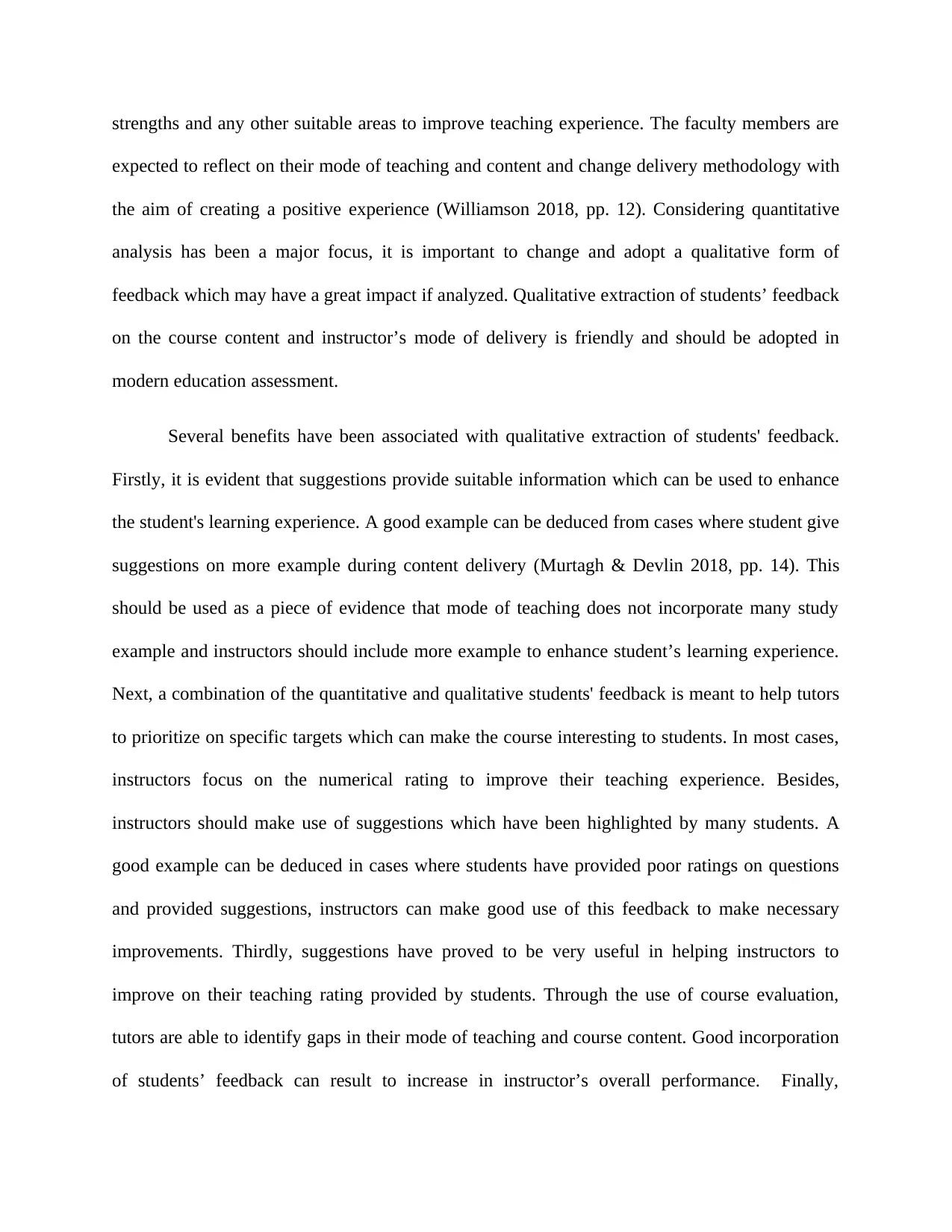
strengths and any other suitable areas to improve teaching experience. The faculty members are
expected to reflect on their mode of teaching and content and change delivery methodology with
the aim of creating a positive experience (Williamson 2018, pp. 12). Considering quantitative
analysis has been a major focus, it is important to change and adopt a qualitative form of
feedback which may have a great impact if analyzed. Qualitative extraction of students’ feedback
on the course content and instructor’s mode of delivery is friendly and should be adopted in
modern education assessment.
Several benefits have been associated with qualitative extraction of students' feedback.
Firstly, it is evident that suggestions provide suitable information which can be used to enhance
the student's learning experience. A good example can be deduced from cases where student give
suggestions on more example during content delivery (Murtagh & Devlin 2018, pp. 14). This
should be used as a piece of evidence that mode of teaching does not incorporate many study
example and instructors should include more example to enhance student’s learning experience.
Next, a combination of the quantitative and qualitative students' feedback is meant to help tutors
to prioritize on specific targets which can make the course interesting to students. In most cases,
instructors focus on the numerical rating to improve their teaching experience. Besides,
instructors should make use of suggestions which have been highlighted by many students. A
good example can be deduced in cases where students have provided poor ratings on questions
and provided suggestions, instructors can make good use of this feedback to make necessary
improvements. Thirdly, suggestions have proved to be very useful in helping instructors to
improve on their teaching rating provided by students. Through the use of course evaluation,
tutors are able to identify gaps in their mode of teaching and course content. Good incorporation
of students’ feedback can result to increase in instructor’s overall performance. Finally,
expected to reflect on their mode of teaching and content and change delivery methodology with
the aim of creating a positive experience (Williamson 2018, pp. 12). Considering quantitative
analysis has been a major focus, it is important to change and adopt a qualitative form of
feedback which may have a great impact if analyzed. Qualitative extraction of students’ feedback
on the course content and instructor’s mode of delivery is friendly and should be adopted in
modern education assessment.
Several benefits have been associated with qualitative extraction of students' feedback.
Firstly, it is evident that suggestions provide suitable information which can be used to enhance
the student's learning experience. A good example can be deduced from cases where student give
suggestions on more example during content delivery (Murtagh & Devlin 2018, pp. 14). This
should be used as a piece of evidence that mode of teaching does not incorporate many study
example and instructors should include more example to enhance student’s learning experience.
Next, a combination of the quantitative and qualitative students' feedback is meant to help tutors
to prioritize on specific targets which can make the course interesting to students. In most cases,
instructors focus on the numerical rating to improve their teaching experience. Besides,
instructors should make use of suggestions which have been highlighted by many students. A
good example can be deduced in cases where students have provided poor ratings on questions
and provided suggestions, instructors can make good use of this feedback to make necessary
improvements. Thirdly, suggestions have proved to be very useful in helping instructors to
improve on their teaching rating provided by students. Through the use of course evaluation,
tutors are able to identify gaps in their mode of teaching and course content. Good incorporation
of students’ feedback can result to increase in instructor’s overall performance. Finally,
⊘ This is a preview!⊘
Do you want full access?
Subscribe today to unlock all pages.

Trusted by 1+ million students worldwide
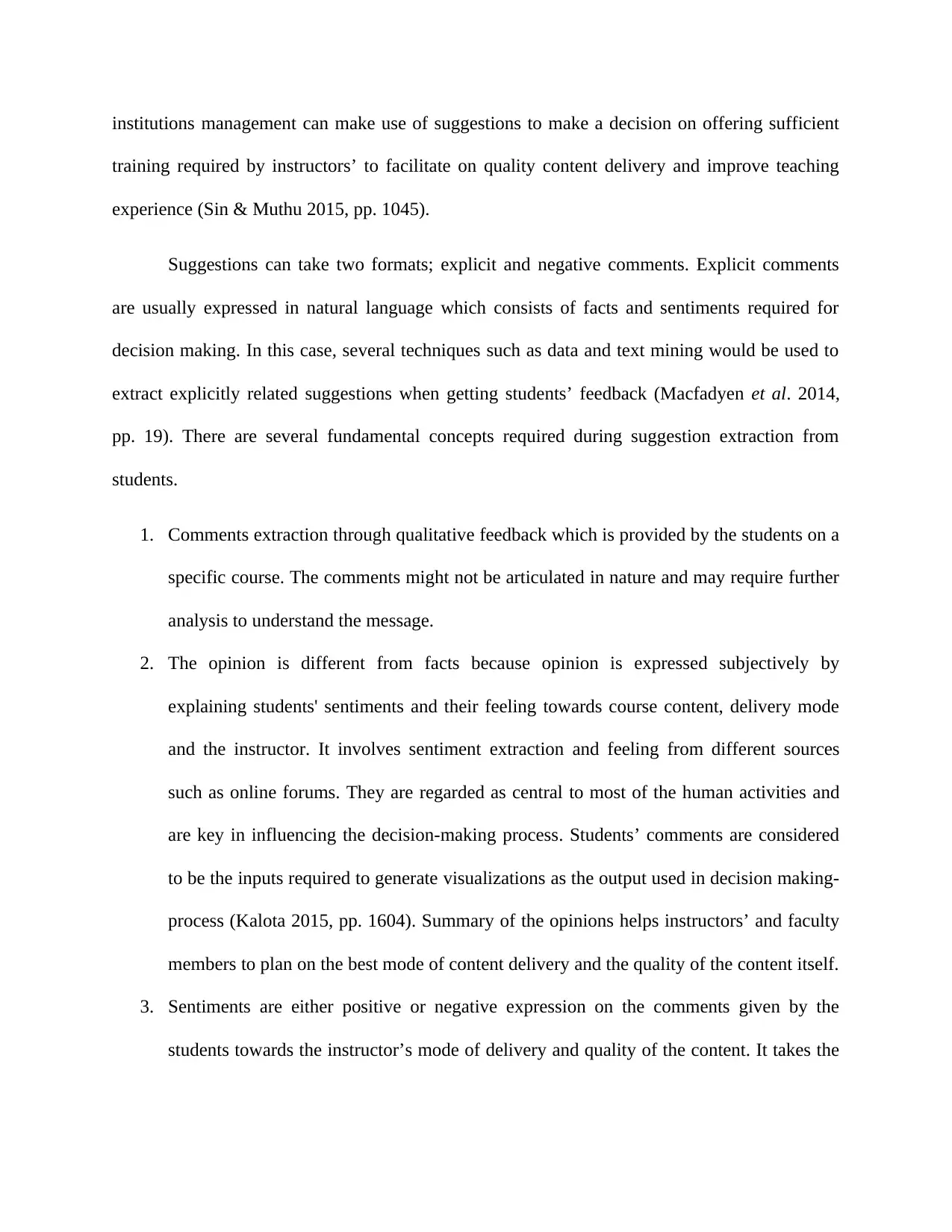
institutions management can make use of suggestions to make a decision on offering sufficient
training required by instructors’ to facilitate on quality content delivery and improve teaching
experience (Sin & Muthu 2015, pp. 1045).
Suggestions can take two formats; explicit and negative comments. Explicit comments
are usually expressed in natural language which consists of facts and sentiments required for
decision making. In this case, several techniques such as data and text mining would be used to
extract explicitly related suggestions when getting students’ feedback (Macfadyen et al. 2014,
pp. 19). There are several fundamental concepts required during suggestion extraction from
students.
1. Comments extraction through qualitative feedback which is provided by the students on a
specific course. The comments might not be articulated in nature and may require further
analysis to understand the message.
2. The opinion is different from facts because opinion is expressed subjectively by
explaining students' sentiments and their feeling towards course content, delivery mode
and the instructor. It involves sentiment extraction and feeling from different sources
such as online forums. They are regarded as central to most of the human activities and
are key in influencing the decision-making process. Students’ comments are considered
to be the inputs required to generate visualizations as the output used in decision making-
process (Kalota 2015, pp. 1604). Summary of the opinions helps instructors’ and faculty
members to plan on the best mode of content delivery and the quality of the content itself.
3. Sentiments are either positive or negative expression on the comments given by the
students towards the instructor’s mode of delivery and quality of the content. It takes the
training required by instructors’ to facilitate on quality content delivery and improve teaching
experience (Sin & Muthu 2015, pp. 1045).
Suggestions can take two formats; explicit and negative comments. Explicit comments
are usually expressed in natural language which consists of facts and sentiments required for
decision making. In this case, several techniques such as data and text mining would be used to
extract explicitly related suggestions when getting students’ feedback (Macfadyen et al. 2014,
pp. 19). There are several fundamental concepts required during suggestion extraction from
students.
1. Comments extraction through qualitative feedback which is provided by the students on a
specific course. The comments might not be articulated in nature and may require further
analysis to understand the message.
2. The opinion is different from facts because opinion is expressed subjectively by
explaining students' sentiments and their feeling towards course content, delivery mode
and the instructor. It involves sentiment extraction and feeling from different sources
such as online forums. They are regarded as central to most of the human activities and
are key in influencing the decision-making process. Students’ comments are considered
to be the inputs required to generate visualizations as the output used in decision making-
process (Kalota 2015, pp. 1604). Summary of the opinions helps instructors’ and faculty
members to plan on the best mode of content delivery and the quality of the content itself.
3. Sentiments are either positive or negative expression on the comments given by the
students towards the instructor’s mode of delivery and quality of the content. It takes the
Paraphrase This Document
Need a fresh take? Get an instant paraphrase of this document with our AI Paraphraser
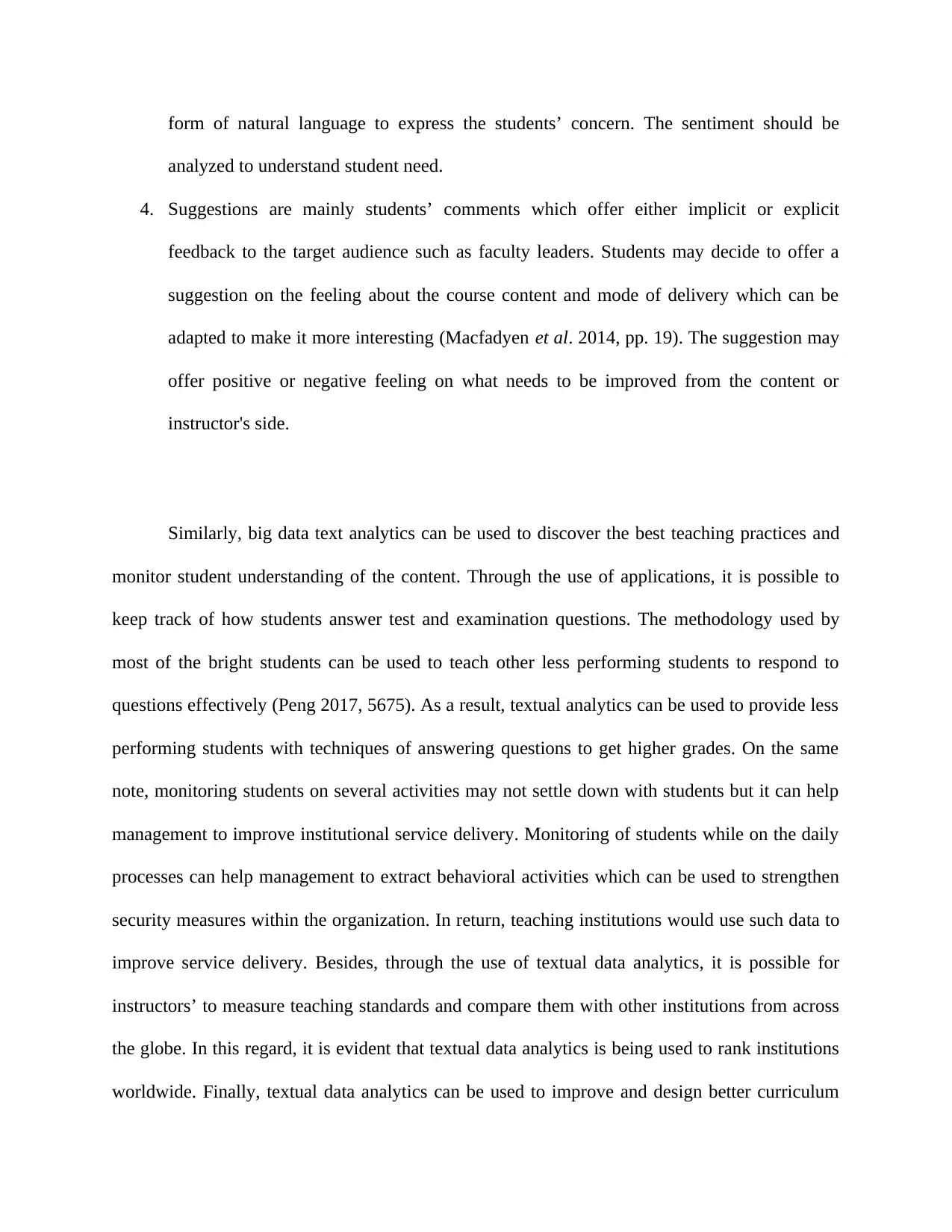
form of natural language to express the students’ concern. The sentiment should be
analyzed to understand student need.
4. Suggestions are mainly students’ comments which offer either implicit or explicit
feedback to the target audience such as faculty leaders. Students may decide to offer a
suggestion on the feeling about the course content and mode of delivery which can be
adapted to make it more interesting (Macfadyen et al. 2014, pp. 19). The suggestion may
offer positive or negative feeling on what needs to be improved from the content or
instructor's side.
Similarly, big data text analytics can be used to discover the best teaching practices and
monitor student understanding of the content. Through the use of applications, it is possible to
keep track of how students answer test and examination questions. The methodology used by
most of the bright students can be used to teach other less performing students to respond to
questions effectively (Peng 2017, 5675). As a result, textual analytics can be used to provide less
performing students with techniques of answering questions to get higher grades. On the same
note, monitoring students on several activities may not settle down with students but it can help
management to improve institutional service delivery. Monitoring of students while on the daily
processes can help management to extract behavioral activities which can be used to strengthen
security measures within the organization. In return, teaching institutions would use such data to
improve service delivery. Besides, through the use of textual data analytics, it is possible for
instructors’ to measure teaching standards and compare them with other institutions from across
the globe. In this regard, it is evident that textual data analytics is being used to rank institutions
worldwide. Finally, textual data analytics can be used to improve and design better curriculum
analyzed to understand student need.
4. Suggestions are mainly students’ comments which offer either implicit or explicit
feedback to the target audience such as faculty leaders. Students may decide to offer a
suggestion on the feeling about the course content and mode of delivery which can be
adapted to make it more interesting (Macfadyen et al. 2014, pp. 19). The suggestion may
offer positive or negative feeling on what needs to be improved from the content or
instructor's side.
Similarly, big data text analytics can be used to discover the best teaching practices and
monitor student understanding of the content. Through the use of applications, it is possible to
keep track of how students answer test and examination questions. The methodology used by
most of the bright students can be used to teach other less performing students to respond to
questions effectively (Peng 2017, 5675). As a result, textual analytics can be used to provide less
performing students with techniques of answering questions to get higher grades. On the same
note, monitoring students on several activities may not settle down with students but it can help
management to improve institutional service delivery. Monitoring of students while on the daily
processes can help management to extract behavioral activities which can be used to strengthen
security measures within the organization. In return, teaching institutions would use such data to
improve service delivery. Besides, through the use of textual data analytics, it is possible for
instructors’ to measure teaching standards and compare them with other institutions from across
the globe. In this regard, it is evident that textual data analytics is being used to rank institutions
worldwide. Finally, textual data analytics can be used to improve and design better curriculum
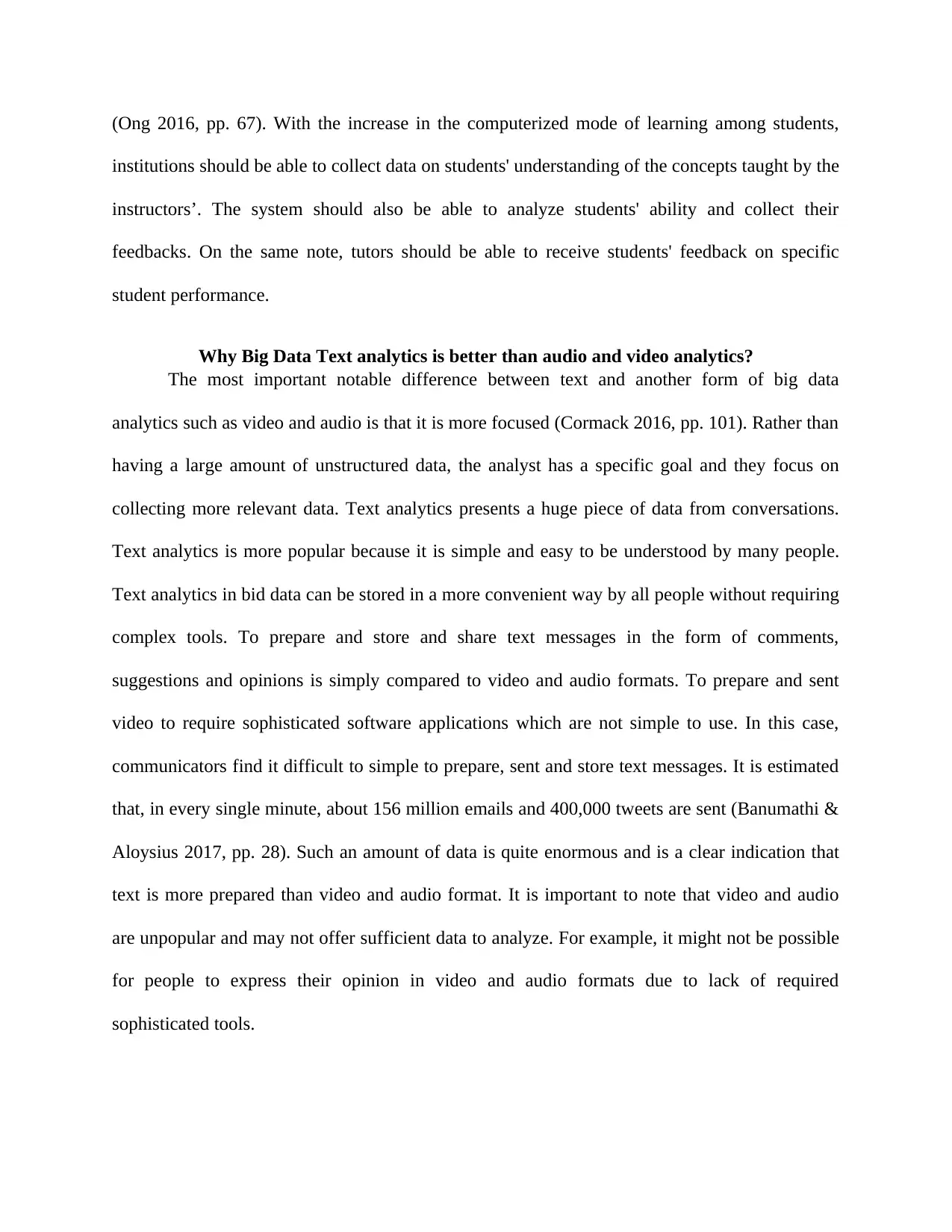
(Ong 2016, pp. 67). With the increase in the computerized mode of learning among students,
institutions should be able to collect data on students' understanding of the concepts taught by the
instructors’. The system should also be able to analyze students' ability and collect their
feedbacks. On the same note, tutors should be able to receive students' feedback on specific
student performance.
Why Big Data Text analytics is better than audio and video analytics?
The most important notable difference between text and another form of big data
analytics such as video and audio is that it is more focused (Cormack 2016, pp. 101). Rather than
having a large amount of unstructured data, the analyst has a specific goal and they focus on
collecting more relevant data. Text analytics presents a huge piece of data from conversations.
Text analytics is more popular because it is simple and easy to be understood by many people.
Text analytics in bid data can be stored in a more convenient way by all people without requiring
complex tools. To prepare and store and share text messages in the form of comments,
suggestions and opinions is simply compared to video and audio formats. To prepare and sent
video to require sophisticated software applications which are not simple to use. In this case,
communicators find it difficult to simple to prepare, sent and store text messages. It is estimated
that, in every single minute, about 156 million emails and 400,000 tweets are sent (Banumathi &
Aloysius 2017, pp. 28). Such an amount of data is quite enormous and is a clear indication that
text is more prepared than video and audio format. It is important to note that video and audio
are unpopular and may not offer sufficient data to analyze. For example, it might not be possible
for people to express their opinion in video and audio formats due to lack of required
sophisticated tools.
institutions should be able to collect data on students' understanding of the concepts taught by the
instructors’. The system should also be able to analyze students' ability and collect their
feedbacks. On the same note, tutors should be able to receive students' feedback on specific
student performance.
Why Big Data Text analytics is better than audio and video analytics?
The most important notable difference between text and another form of big data
analytics such as video and audio is that it is more focused (Cormack 2016, pp. 101). Rather than
having a large amount of unstructured data, the analyst has a specific goal and they focus on
collecting more relevant data. Text analytics presents a huge piece of data from conversations.
Text analytics is more popular because it is simple and easy to be understood by many people.
Text analytics in bid data can be stored in a more convenient way by all people without requiring
complex tools. To prepare and store and share text messages in the form of comments,
suggestions and opinions is simply compared to video and audio formats. To prepare and sent
video to require sophisticated software applications which are not simple to use. In this case,
communicators find it difficult to simple to prepare, sent and store text messages. It is estimated
that, in every single minute, about 156 million emails and 400,000 tweets are sent (Banumathi &
Aloysius 2017, pp. 28). Such an amount of data is quite enormous and is a clear indication that
text is more prepared than video and audio format. It is important to note that video and audio
are unpopular and may not offer sufficient data to analyze. For example, it might not be possible
for people to express their opinion in video and audio formats due to lack of required
sophisticated tools.
⊘ This is a preview!⊘
Do you want full access?
Subscribe today to unlock all pages.

Trusted by 1+ million students worldwide
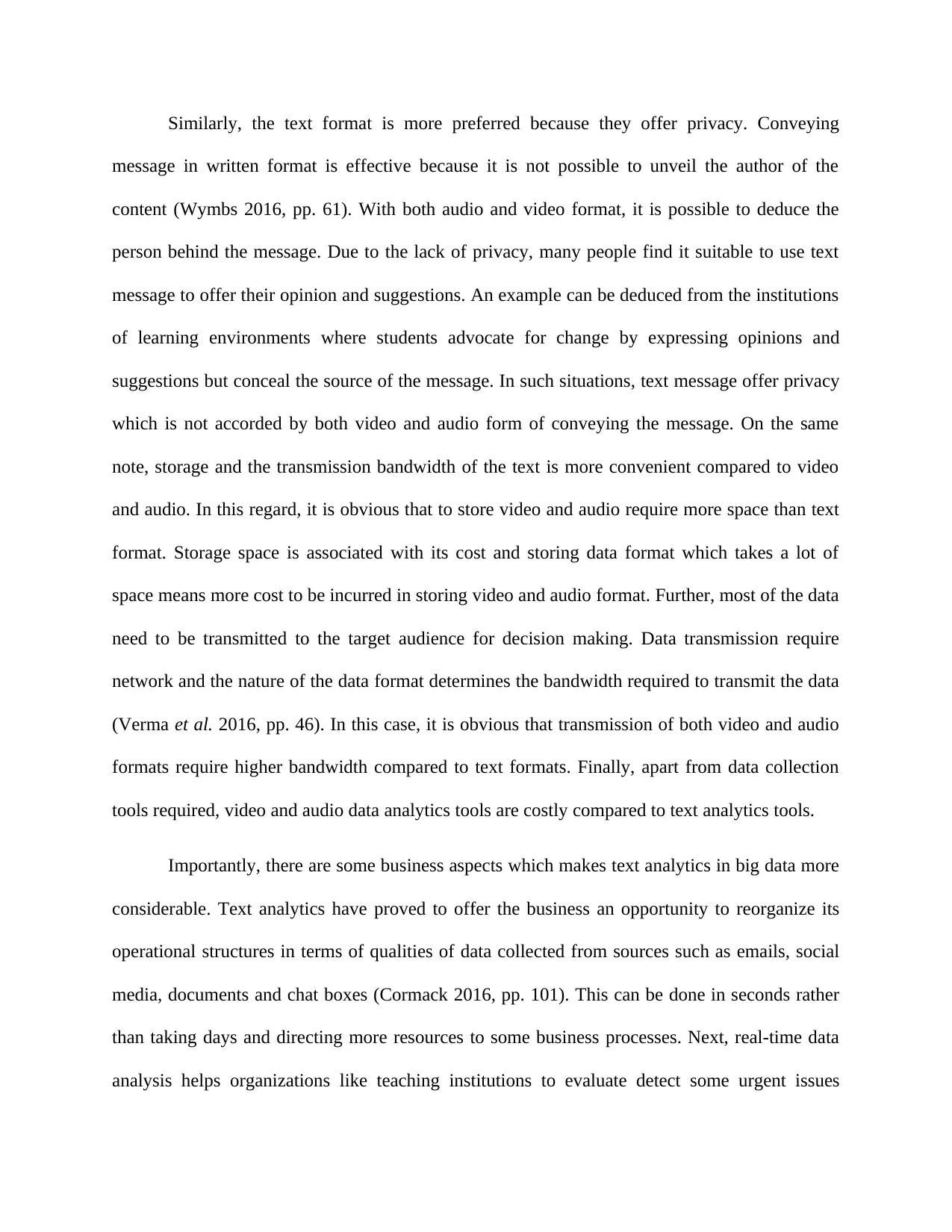
Similarly, the text format is more preferred because they offer privacy. Conveying
message in written format is effective because it is not possible to unveil the author of the
content (Wymbs 2016, pp. 61). With both audio and video format, it is possible to deduce the
person behind the message. Due to the lack of privacy, many people find it suitable to use text
message to offer their opinion and suggestions. An example can be deduced from the institutions
of learning environments where students advocate for change by expressing opinions and
suggestions but conceal the source of the message. In such situations, text message offer privacy
which is not accorded by both video and audio form of conveying the message. On the same
note, storage and the transmission bandwidth of the text is more convenient compared to video
and audio. In this regard, it is obvious that to store video and audio require more space than text
format. Storage space is associated with its cost and storing data format which takes a lot of
space means more cost to be incurred in storing video and audio format. Further, most of the data
need to be transmitted to the target audience for decision making. Data transmission require
network and the nature of the data format determines the bandwidth required to transmit the data
(Verma et al. 2016, pp. 46). In this case, it is obvious that transmission of both video and audio
formats require higher bandwidth compared to text formats. Finally, apart from data collection
tools required, video and audio data analytics tools are costly compared to text analytics tools.
Importantly, there are some business aspects which makes text analytics in big data more
considerable. Text analytics have proved to offer the business an opportunity to reorganize its
operational structures in terms of qualities of data collected from sources such as emails, social
media, documents and chat boxes (Cormack 2016, pp. 101). This can be done in seconds rather
than taking days and directing more resources to some business processes. Next, real-time data
analysis helps organizations like teaching institutions to evaluate detect some urgent issues
message in written format is effective because it is not possible to unveil the author of the
content (Wymbs 2016, pp. 61). With both audio and video format, it is possible to deduce the
person behind the message. Due to the lack of privacy, many people find it suitable to use text
message to offer their opinion and suggestions. An example can be deduced from the institutions
of learning environments where students advocate for change by expressing opinions and
suggestions but conceal the source of the message. In such situations, text message offer privacy
which is not accorded by both video and audio form of conveying the message. On the same
note, storage and the transmission bandwidth of the text is more convenient compared to video
and audio. In this regard, it is obvious that to store video and audio require more space than text
format. Storage space is associated with its cost and storing data format which takes a lot of
space means more cost to be incurred in storing video and audio format. Further, most of the data
need to be transmitted to the target audience for decision making. Data transmission require
network and the nature of the data format determines the bandwidth required to transmit the data
(Verma et al. 2016, pp. 46). In this case, it is obvious that transmission of both video and audio
formats require higher bandwidth compared to text formats. Finally, apart from data collection
tools required, video and audio data analytics tools are costly compared to text analytics tools.
Importantly, there are some business aspects which makes text analytics in big data more
considerable. Text analytics have proved to offer the business an opportunity to reorganize its
operational structures in terms of qualities of data collected from sources such as emails, social
media, documents and chat boxes (Cormack 2016, pp. 101). This can be done in seconds rather
than taking days and directing more resources to some business processes. Next, real-time data
analysis helps organizations like teaching institutions to evaluate detect some urgent issues
Paraphrase This Document
Need a fresh take? Get an instant paraphrase of this document with our AI Paraphraser
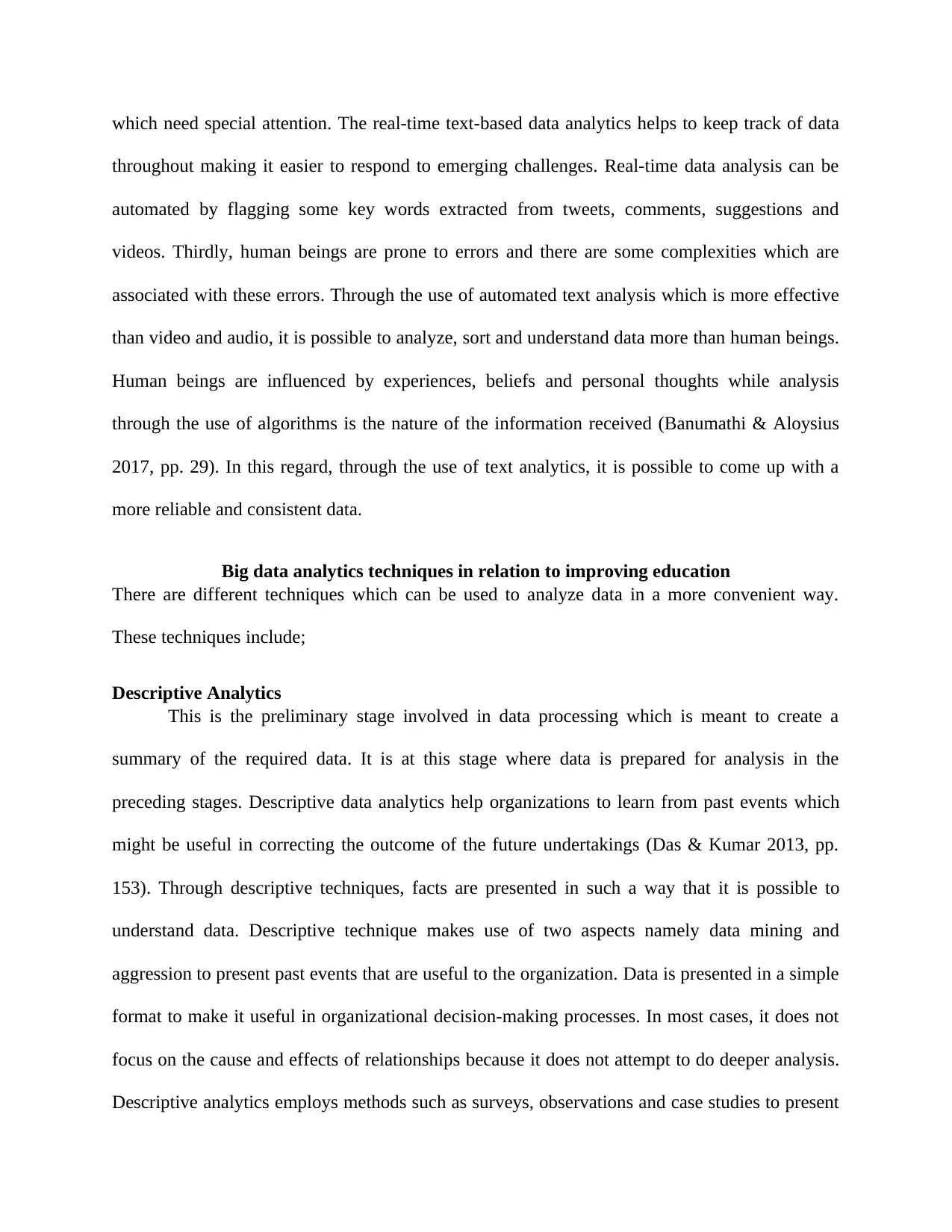
which need special attention. The real-time text-based data analytics helps to keep track of data
throughout making it easier to respond to emerging challenges. Real-time data analysis can be
automated by flagging some key words extracted from tweets, comments, suggestions and
videos. Thirdly, human beings are prone to errors and there are some complexities which are
associated with these errors. Through the use of automated text analysis which is more effective
than video and audio, it is possible to analyze, sort and understand data more than human beings.
Human beings are influenced by experiences, beliefs and personal thoughts while analysis
through the use of algorithms is the nature of the information received (Banumathi & Aloysius
2017, pp. 29). In this regard, through the use of text analytics, it is possible to come up with a
more reliable and consistent data.
Big data analytics techniques in relation to improving education
There are different techniques which can be used to analyze data in a more convenient way.
These techniques include;
Descriptive Analytics
This is the preliminary stage involved in data processing which is meant to create a
summary of the required data. It is at this stage where data is prepared for analysis in the
preceding stages. Descriptive data analytics help organizations to learn from past events which
might be useful in correcting the outcome of the future undertakings (Das & Kumar 2013, pp.
153). Through descriptive techniques, facts are presented in such a way that it is possible to
understand data. Descriptive technique makes use of two aspects namely data mining and
aggression to present past events that are useful to the organization. Data is presented in a simple
format to make it useful in organizational decision-making processes. In most cases, it does not
focus on the cause and effects of relationships because it does not attempt to do deeper analysis.
Descriptive analytics employs methods such as surveys, observations and case studies to present
throughout making it easier to respond to emerging challenges. Real-time data analysis can be
automated by flagging some key words extracted from tweets, comments, suggestions and
videos. Thirdly, human beings are prone to errors and there are some complexities which are
associated with these errors. Through the use of automated text analysis which is more effective
than video and audio, it is possible to analyze, sort and understand data more than human beings.
Human beings are influenced by experiences, beliefs and personal thoughts while analysis
through the use of algorithms is the nature of the information received (Banumathi & Aloysius
2017, pp. 29). In this regard, through the use of text analytics, it is possible to come up with a
more reliable and consistent data.
Big data analytics techniques in relation to improving education
There are different techniques which can be used to analyze data in a more convenient way.
These techniques include;
Descriptive Analytics
This is the preliminary stage involved in data processing which is meant to create a
summary of the required data. It is at this stage where data is prepared for analysis in the
preceding stages. Descriptive data analytics help organizations to learn from past events which
might be useful in correcting the outcome of the future undertakings (Das & Kumar 2013, pp.
153). Through descriptive techniques, facts are presented in such a way that it is possible to
understand data. Descriptive technique makes use of two aspects namely data mining and
aggression to present past events that are useful to the organization. Data is presented in a simple
format to make it useful in organizational decision-making processes. In most cases, it does not
focus on the cause and effects of relationships because it does not attempt to do deeper analysis.
Descriptive analytics employs methods such as surveys, observations and case studies to present
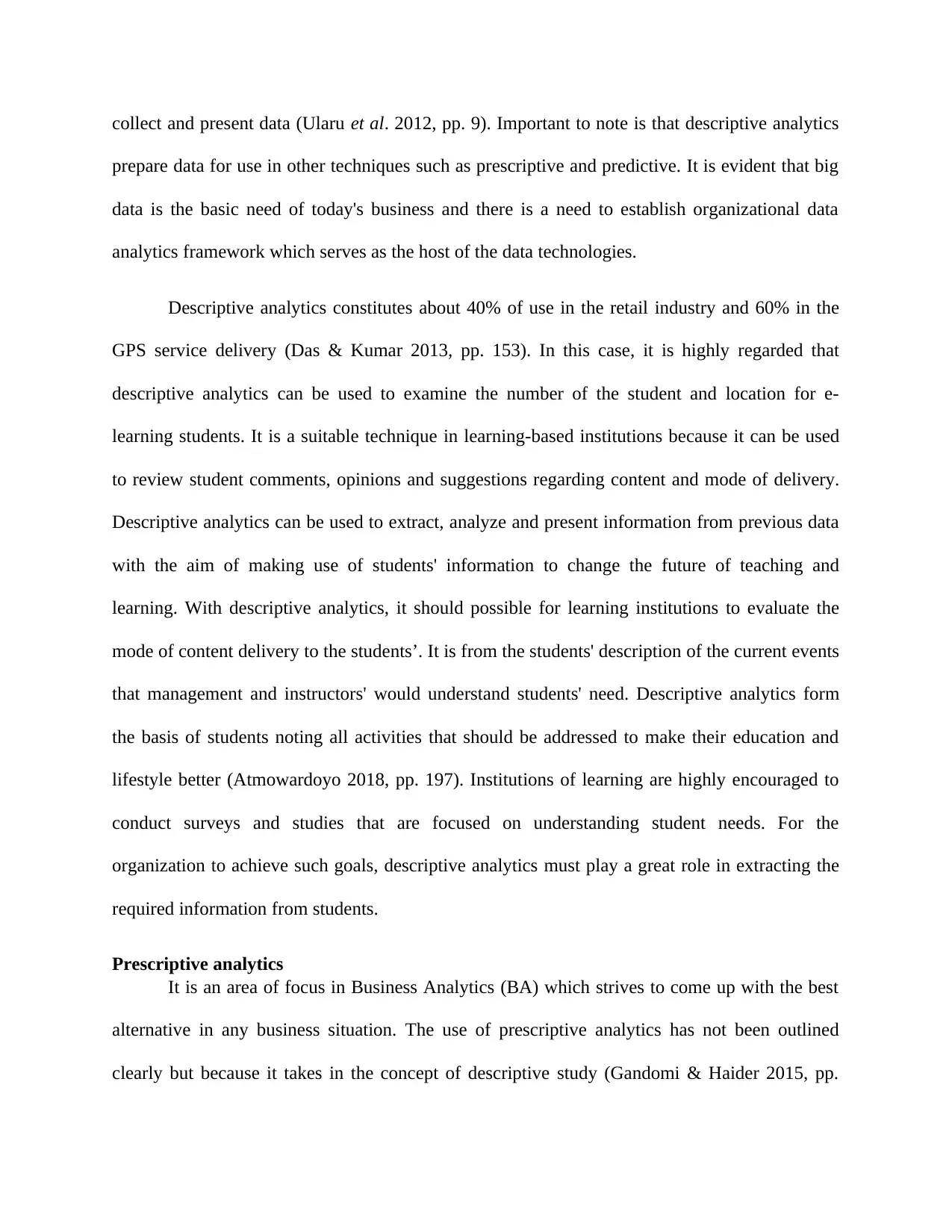
collect and present data (Ularu et al. 2012, pp. 9). Important to note is that descriptive analytics
prepare data for use in other techniques such as prescriptive and predictive. It is evident that big
data is the basic need of today's business and there is a need to establish organizational data
analytics framework which serves as the host of the data technologies.
Descriptive analytics constitutes about 40% of use in the retail industry and 60% in the
GPS service delivery (Das & Kumar 2013, pp. 153). In this case, it is highly regarded that
descriptive analytics can be used to examine the number of the student and location for e-
learning students. It is a suitable technique in learning-based institutions because it can be used
to review student comments, opinions and suggestions regarding content and mode of delivery.
Descriptive analytics can be used to extract, analyze and present information from previous data
with the aim of making use of students' information to change the future of teaching and
learning. With descriptive analytics, it should possible for learning institutions to evaluate the
mode of content delivery to the students’. It is from the students' description of the current events
that management and instructors' would understand students' need. Descriptive analytics form
the basis of students noting all activities that should be addressed to make their education and
lifestyle better (Atmowardoyo 2018, pp. 197). Institutions of learning are highly encouraged to
conduct surveys and studies that are focused on understanding student needs. For the
organization to achieve such goals, descriptive analytics must play a great role in extracting the
required information from students.
Prescriptive analytics
It is an area of focus in Business Analytics (BA) which strives to come up with the best
alternative in any business situation. The use of prescriptive analytics has not been outlined
clearly but because it takes in the concept of descriptive study (Gandomi & Haider 2015, pp.
prepare data for use in other techniques such as prescriptive and predictive. It is evident that big
data is the basic need of today's business and there is a need to establish organizational data
analytics framework which serves as the host of the data technologies.
Descriptive analytics constitutes about 40% of use in the retail industry and 60% in the
GPS service delivery (Das & Kumar 2013, pp. 153). In this case, it is highly regarded that
descriptive analytics can be used to examine the number of the student and location for e-
learning students. It is a suitable technique in learning-based institutions because it can be used
to review student comments, opinions and suggestions regarding content and mode of delivery.
Descriptive analytics can be used to extract, analyze and present information from previous data
with the aim of making use of students' information to change the future of teaching and
learning. With descriptive analytics, it should possible for learning institutions to evaluate the
mode of content delivery to the students’. It is from the students' description of the current events
that management and instructors' would understand students' need. Descriptive analytics form
the basis of students noting all activities that should be addressed to make their education and
lifestyle better (Atmowardoyo 2018, pp. 197). Institutions of learning are highly encouraged to
conduct surveys and studies that are focused on understanding student needs. For the
organization to achieve such goals, descriptive analytics must play a great role in extracting the
required information from students.
Prescriptive analytics
It is an area of focus in Business Analytics (BA) which strives to come up with the best
alternative in any business situation. The use of prescriptive analytics has not been outlined
clearly but because it takes in the concept of descriptive study (Gandomi & Haider 2015, pp.
⊘ This is a preview!⊘
Do you want full access?
Subscribe today to unlock all pages.

Trusted by 1+ million students worldwide
1 out of 18
Related Documents
Your All-in-One AI-Powered Toolkit for Academic Success.
+13062052269
info@desklib.com
Available 24*7 on WhatsApp / Email
![[object Object]](/_next/static/media/star-bottom.7253800d.svg)
Unlock your academic potential
Copyright © 2020–2025 A2Z Services. All Rights Reserved. Developed and managed by ZUCOL.



